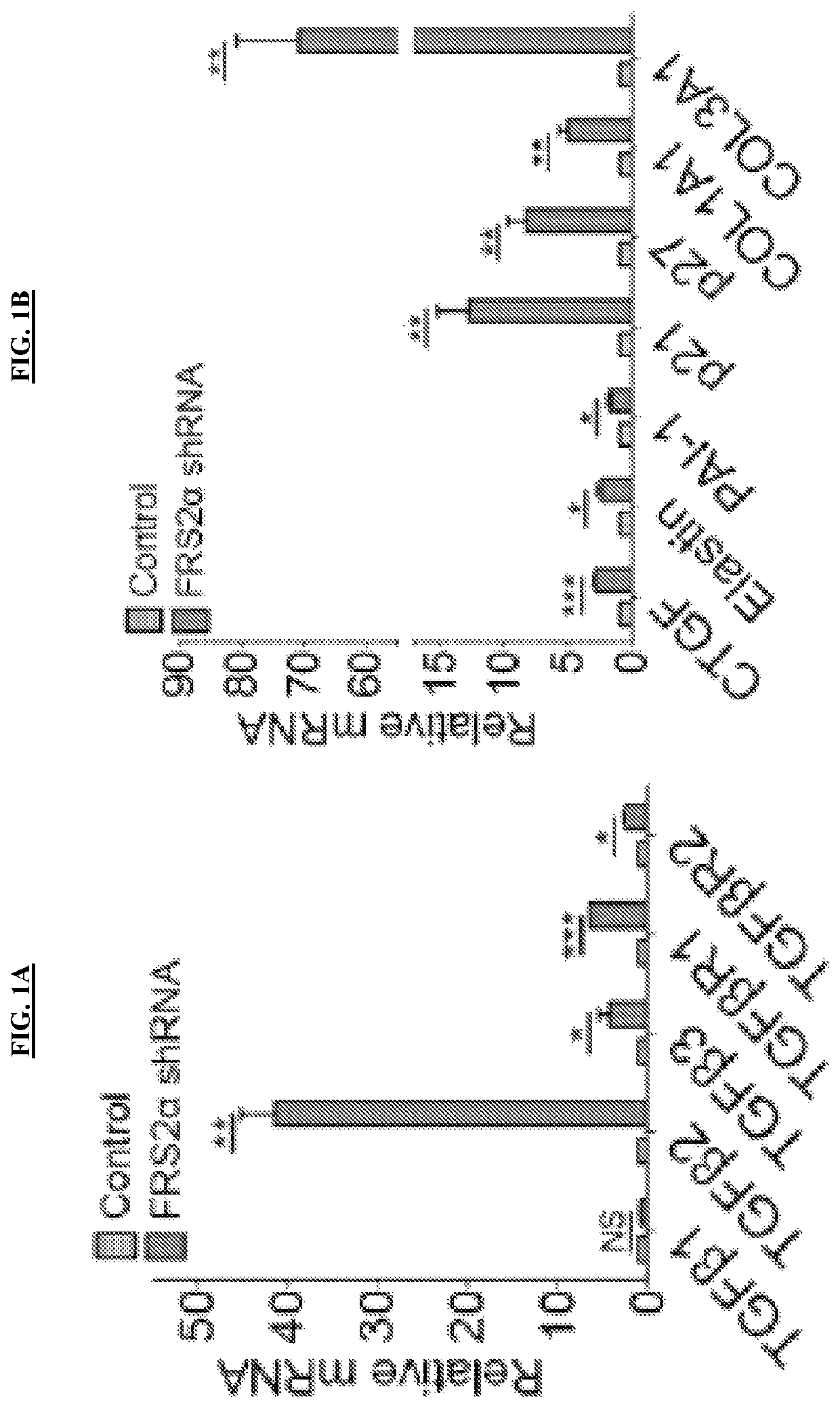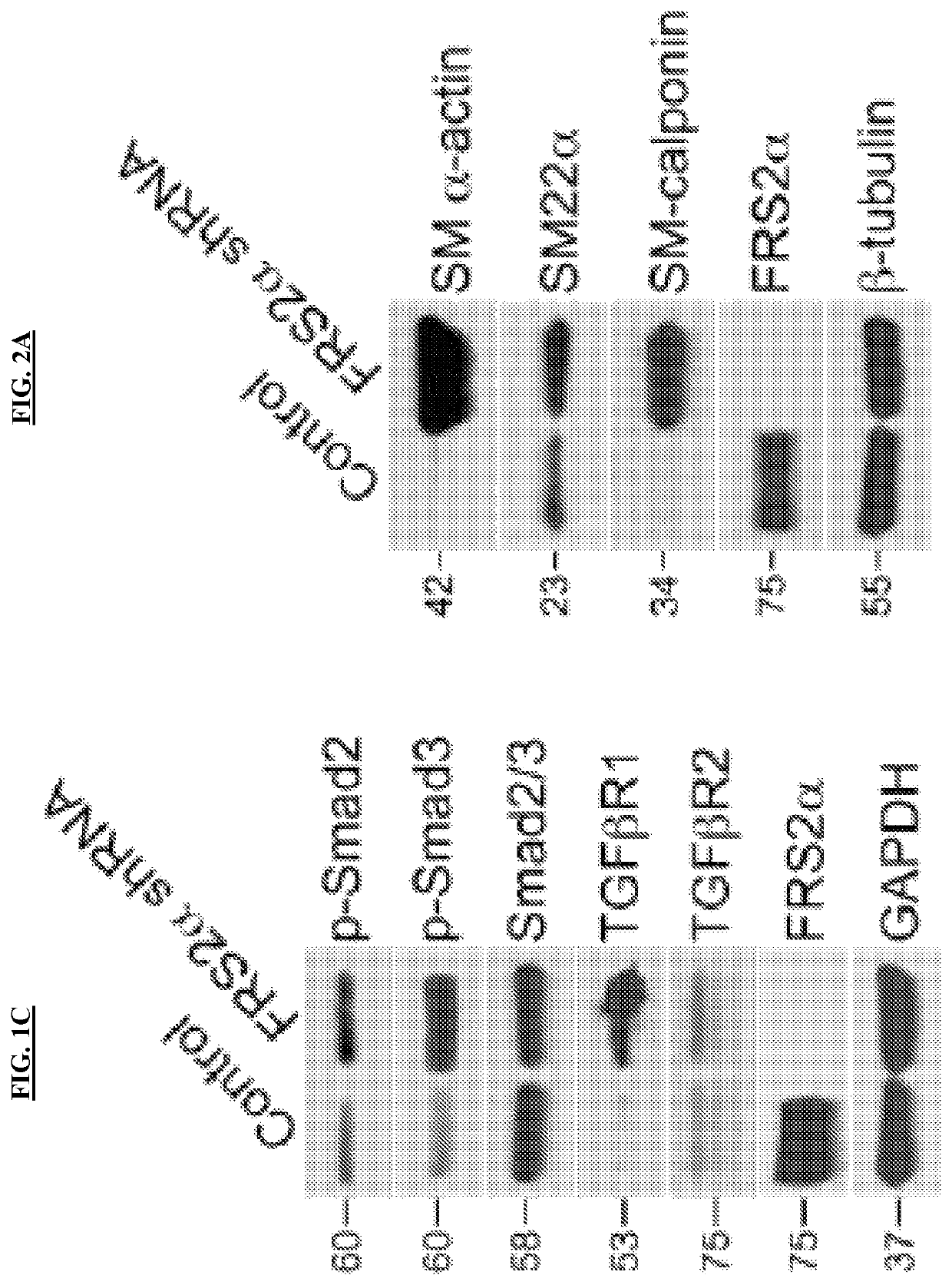Methods and compositions for treating atherosclerosis
a technology of atherosclerosis and compositions, applied in the direction of drug compositions, cardiovascular disorders, microcapsules, etc., can solve the problems of not stopping or reversed disease progression, no currently available therapy to stop the development of atherosclerosis, and the mechanism of this effect and its functional consequences have not been fully established. , to achieve the effect of reducing the immune response to the mirna and increasing the stability of the mirna
- Summary
- Abstract
- Description
- Claims
- Application Information
AI Technical Summary
Benefits of technology
Problems solved by technology
Method used
Image
Examples
example 1
ulates TGFβ Activity and SMC Differentiation
[0275]Inhibition of FGF signaling in SMCs using FRS2α knockdown and its effect on the expression of TGFβ pathway signaling molecules was examined. In cultured human aortic smooth muscle cells (HASMCs), knockdown of FRS2α led to a significant increase in expression of TGFβ2, TGFβ3, TGFβR1, and TGFβR2 (FIG. 1A). TGFβ1 was unchanged. In addition, there was an increase in the expression of a number of TGFβ-dependent genes including connective tissue growth factor (CTGF), elastin, plasminogen activator inhibitor-1 (PAI-1), p21, p27, and collagen (FIG. 1B) suggesting activation of TGFβ signaling. This was confirmed by Western blotting that demonstrated increase phosphorylation of Smad2 and Smad3 following FRS2α knockdown (FIG. 1C).
[0276]Cultured SMCs in serum-supplemented medium lose differentiation marker expression and acquire a synthetic (proliferative) phenotype. Since activation of TGFβ signaling has been linked with the induction of SMC di...
example 2
Let-7 Mediate FGF-Driven Suppression of TGFβ Signaling in SMCs
[0279]FRS2α is involved in signaling of all four FGF receptors. The following experiments were conducted to establish the principal FGFR responsible for suppression of TGFβ signaling in SMC. qPCR analysis demonstrated that FGFR1 was the main FGFR expressed in cultured HASMCs (FIG. 10A). In agreement with that finding, shRNA-mediated FGFR1 knockdown markedly increased TGFβ2, TGFβ3, TGFβR1 and TGFβR2 expression (FIG. 10B) in a manner similar to that of the FRS2α knockdown. This also led to activation of TGFβ signaling as demonstrated by increased expression of a number of TGFβ-dependent genes and transcription factors (FIGS. 10C-10D). Western blotting confirmed activation of TGFβ signaling as demonstrated by increased Smad2 and Smad3 phosphorylation and increased contractile SMC gene expression (FIG. 10E).
[0280]It was previously showed that suppression of FGF signaling in endothelial cells decreases expression of let-7 miRN...
example 3
n of FGF and Loss of TGFβ Signaling in Human and Mouse Atherosclerotic Lesions
[0283]To examine the role played by FGF regulation of TGFβ signaling activity in SMCs in disease settings, the correlation between medial FGF and TGFβ signaling and the severity of atherosclerosis in samples of left main coronary arteries from forty-three patients was first evaluated (FIGS. 4A-4B). Table 1 summarizes clinical characteristics of this patient group. Immunostaining of serial left main coronary artery sections for SM α-actin and SM-MHC revealed decreased expression of these contractile SMC markers in the media of arteries from patients with moderate and severe coronary atherosclerosis compared to patients with No / mild disease (FIGS. 4C-4D), consistent with previous findings (Aikawa et al, 1995, Annals of the New York Academy of Sciences 748: 578-585; Aikawa et al, 1993, Circulation research 73: 1000-1012; Glukhova et al, 1988, Proc Natl Acad Sci USA 85: 9542-9546). At the same time, there was ...
PUM
| Property | Measurement | Unit |
|---|---|---|
| temperatures | aaaaa | aaaaa |
| temperatures | aaaaa | aaaaa |
| temperatures | aaaaa | aaaaa |
Abstract
Description
Claims
Application Information
 Login to View More
Login to View More - R&D
- Intellectual Property
- Life Sciences
- Materials
- Tech Scout
- Unparalleled Data Quality
- Higher Quality Content
- 60% Fewer Hallucinations
Browse by: Latest US Patents, China's latest patents, Technical Efficacy Thesaurus, Application Domain, Technology Topic, Popular Technical Reports.
© 2025 PatSnap. All rights reserved.Legal|Privacy policy|Modern Slavery Act Transparency Statement|Sitemap|About US| Contact US: help@patsnap.com



